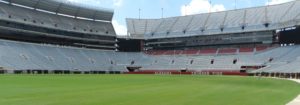Posts Tagged ‘Nebraska’
» posted on Friday, July 8th, 2022 by Linda Lou Burton
What It Was, Was Football
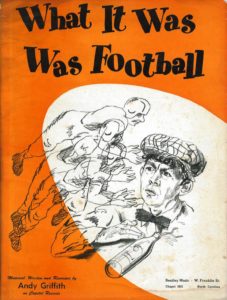 Originally Published July 11, 2020 by Linda Lou Burton posting from Little Rock, Arkansas – “What It Was, Was Football,” a monologue by Andy Griffith credited with launching his career, remains one of the biggest-selling comedy records of all time. And it IS funny. “Deacon Andy” thinks he is going to a tent revival when he stumbles into a college football game by accident. He doesn’t understand why they keep kicking a little pumpkin around. “And they was fightin’ each other for it!” he exclaims.
Originally Published July 11, 2020 by Linda Lou Burton posting from Little Rock, Arkansas – “What It Was, Was Football,” a monologue by Andy Griffith credited with launching his career, remains one of the biggest-selling comedy records of all time. And it IS funny. “Deacon Andy” thinks he is going to a tent revival when he stumbles into a college football game by accident. He doesn’t understand why they keep kicking a little pumpkin around. “And they was fightin’ each other for it!” he exclaims.
“Kicking the pumpkin” nowadays has soared far beyond sport, entertainment, or even tradition to become the biggest revenue producer for many a university. At the University of Texas, for example, 70% of its revenue from athletics comes from football.
Football funds NCAA sports and provides scholarships for college athletes. Football provides college athletes the opportunity to compete for a championship, and the fame and fortune that entails. Football helps to fund Association-wide legal services, communications, business insurance, and the list goes on.
Now it’s time for me to confess: I myself am not a football fan. My claim to fame is being at the University of Alabama the year Bear Bryant came to town. During his first year, I’d grab a hamburger after work and park the car by the fence to watch the magic on the practice field. I understand the love for the game. I understand that football is a force, a magnetic force pulling in a fan base whose loyalty is unexplainable. If you are born in Alabama, for instance, you are pledged at birth to be a lifelong Alabama or Auburn fan, and that loyalty is simply a way of life, even if you never set foot on a campus.
The ten most powerful fan bases in college football last year were, by one pick: Alabama, Michigan, Nebraska, Notre Dame, Ohio State, Oklahoma, Penn State, Tennessee, Texas A & M, Texas. From Roll Tide to Hook’em Horns, don’t get in their way when it’s game time.
If you’ve been keeping up with the impact of COVID-19 on sports, you are aware of some serious shakeups about to happen to fall college football schedules. The Power Five – the Atlantic Coast Conference (ACC), Big Ten Conference, Big 12 Conference, Pac-12 Conference, and Southeastern Conference (SEC) have made shattering announcements this week, with more to come, as football fans everywhere wait to hear the news.
 Yesterday it was announced that the Pac-12 Conference is canceling all its non-conference games for the season; just after that it was revealed that Larry Scott, Commissioner of the Pac-12 Conference, is battling COVID-19. Impact for the first game of the season: no USC vs Alabama on September 5. Financially for Alabama, that is a loss of $6 million.
Yesterday it was announced that the Pac-12 Conference is canceling all its non-conference games for the season; just after that it was revealed that Larry Scott, Commissioner of the Pac-12 Conference, is battling COVID-19. Impact for the first game of the season: no USC vs Alabama on September 5. Financially for Alabama, that is a loss of $6 million.
That’s just one example, for one school, on one football weekend.
The shoe had dropped the day before, as The Big Ten was first to announce a “conference only” schedule for this season; this impacts all sports, details are still in the making as conversations take place between the Big Ten Council of Presidents, Directors of Athletics, staff and medical experts. But Ohio State and Oregon, September 12, canceled for sure.
Two Conferences decided; three to go.
ACC Commissioner John Wofford: The health and safety of our student-athletes, coaches and administrators remains the ACC’s top priority…..The league membership and our medical advisory group will make every effort to be as prepared as possible during these unprecedented times, and we anticipate a decision by our Board of Directors in late July.
SEC Commissioner Greg Sankey: We are running out of time to make a decision. What do we have to do to get back to activity? The direct reality is not good…we owe it to each other to be as healthy as we can be.
Big 12 Conference Commissioner Bob Bowlsby: The ideal situation remains a full 12-game schedule that starts on Labor Day weekend.
The Power Five Conferences are not the whole of it. There are 10 conferences and 130 schools in the Football Bowl Subdivision, and I can’t count beyond that. The point is: “kicking a pumpkin” is part of the American scene. Yes, there is a great deal of money to be lost if COVID-19 knocks a hole in this season’s football schedules. But the sheer fun of the game for millions of fans is an even bigger loss.
What it WAS, was football – is that what fans will be left saying this fall on Saturday afternoons? That’s not funny.
» posted on Wednesday, September 30th, 2015 by Linda Lou Burton
An Invite From CRAG
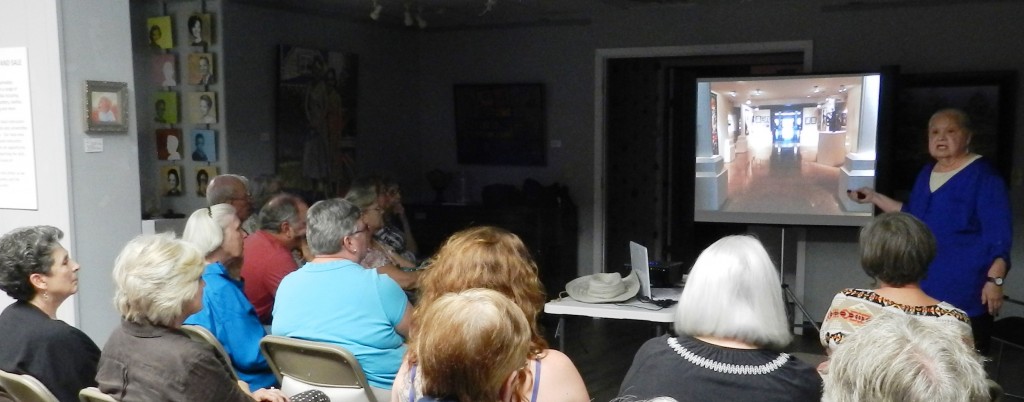 Linda Burton posting from Arkadelphia, Arkansas — I was invited to speak at the September 24 meeting of the Caddo River Art Guild (CRAG), an avid group whose mission is promoting art and artists in south central Arkansas, http://caddoriverartguild.com/. My mission of course is capital cities, so I talked about “art in the capital cities,” that is, the community’s support of the arts. How Art Thrives was my topic, leading with the question: What does it take to have a thriving arts community?
Linda Burton posting from Arkadelphia, Arkansas — I was invited to speak at the September 24 meeting of the Caddo River Art Guild (CRAG), an avid group whose mission is promoting art and artists in south central Arkansas, http://caddoriverartguild.com/. My mission of course is capital cities, so I talked about “art in the capital cities,” that is, the community’s support of the arts. How Art Thrives was my topic, leading with the question: What does it take to have a thriving arts community?
It takes four things, I proposed, to nods of agreement from around the room:
• Money
• Artists
• Volunteers
• Attitude
I selected five uniquely different cities to illustrate:
Santa Fe, New Mexico, Population 67, 947 (about 6 Arkadelphias) because it supports and focuses on the artist more than any other capital city.
Montpelier, Vermont, Population 7,855 (about 3/4 of 1 Arkadelphia!) because it’s the smallest capital city and has the 2nd most artists per capita and the biggest group of volunteers.
And Helena, Montana, Population 28,190 (about 3 Arkadelphias), Lincoln, Nebraska, Population 258,379 (about 24 Arkadelphias), and Indianapolis, Indiana, Population 820,444 (about 77 Arkadelphias) to show it’s not the size of the city that matters, it’s the attitude of its residents. » read more
» posted on Sunday, June 23rd, 2013 by Linda Lou Burton
Go Big Red
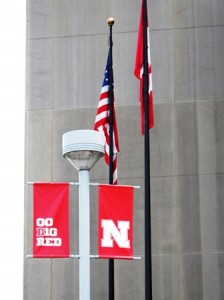 Linda Burton posting from Lincoln, Nebraska – I stared at them all during lunch. Red back-to-back “N”s all across the wall in a Mexican restaurant that didn’t have “N” in its name. So I finally asked what they meant. My server just stared at me. “Nebraska,” she finally answered, as though she couldn’t believe anyone would have to ask. “This is Nebraska. Go Big Red.” Properly chagrined, I replied, “Well I knew that. I just didn’t know why the “N”s were here.” “They are everywhere,” she laughed. “Everything in Lincoln is Nebraska Red.” And so it is; the University of Nebraska in Lincoln, the state’s oldest and largest university and the flagship of the University of Nebraska system. It all started back in 1869, two years after statehood, when it was chartered by the legislature as a land grant university under the 1862 Morrill Act. It was laid out on four city
Linda Burton posting from Lincoln, Nebraska – I stared at them all during lunch. Red back-to-back “N”s all across the wall in a Mexican restaurant that didn’t have “N” in its name. So I finally asked what they meant. My server just stared at me. “Nebraska,” she finally answered, as though she couldn’t believe anyone would have to ask. “This is Nebraska. Go Big Red.” Properly chagrined, I replied, “Well I knew that. I just didn’t know why the “N”s were here.” “They are everywhere,” she laughed. “Everything in Lincoln is Nebraska Red.” And so it is; the University of Nebraska in Lincoln, the state’s oldest and largest university and the flagship of the University of Nebraska system. It all started back in 1869, two years after statehood, when it was chartered by the legislature as a land grant university under the 1862 Morrill Act. It was laid out on four city 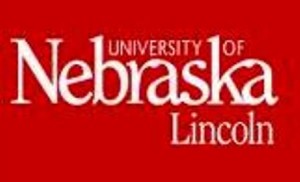 blocks and had one building. Today two campuses in Lincoln cover 2,815 acres and the university is organized into eight colleges with over 100 buildings and research facilities. City Campus is north of downtown, and south of the old fairgrounds; East Campus is two miles east-northeast of that. In addition, UNL has a 25-acre technology park on the north side of town, supplied by modern high-tech laboratories on artificial intelligence, the first
blocks and had one building. Today two campuses in Lincoln cover 2,815 acres and the university is organized into eight colleges with over 100 buildings and research facilities. City Campus is north of downtown, and south of the old fairgrounds; East Campus is two miles east-northeast of that. In addition, UNL has a 25-acre technology park on the north side of town, supplied by modern high-tech laboratories on artificial intelligence, the first  endeavor of its kind in the state. The Nebraska Innovation Campus, on 249 more acres, is being planned to house agricultural biotechnology and other life science research. And then there is the athletic program. The Cornhuskers football team has won 46 conference and five national championships; the women’s volleyball team has won three national championships. Memorial Stadium holds 85,000 and sells out every game. This year eight home games are scheduled; great joy in Lincoln over that. » read more
endeavor of its kind in the state. The Nebraska Innovation Campus, on 249 more acres, is being planned to house agricultural biotechnology and other life science research. And then there is the athletic program. The Cornhuskers football team has won 46 conference and five national championships; the women’s volleyball team has won three national championships. Memorial Stadium holds 85,000 and sells out every game. This year eight home games are scheduled; great joy in Lincoln over that. » read more
» posted on Friday, June 21st, 2013 by Linda Lou Burton
Looking Up
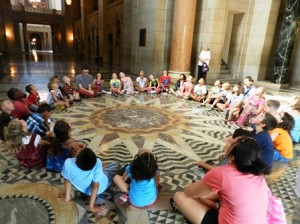 Linda Burton posting from Lincoln, Nebraska – “Sit around this circle and look up,” Jamison the Tour Guide instructed the kids. They plopped to the floor and so did he, right in their midst. The rest of us kept standing; an appropriate entourage of parents, one grandma, a couple from Germany, and me. We exchanged glances, acknowledging our inability to gracefully plop; then grandma and I found a bench. Meanwhile, the kids kept looking up, and up, as Jamison pointed and told stories. “See the man behind the plow?” he said, and directed everyone to look at a large mural on the wall high above our heads. The children nodded. “The grass is
Linda Burton posting from Lincoln, Nebraska – “Sit around this circle and look up,” Jamison the Tour Guide instructed the kids. They plopped to the floor and so did he, right in their midst. The rest of us kept standing; an appropriate entourage of parents, one grandma, a couple from Germany, and me. We exchanged glances, acknowledging our inability to gracefully plop; then grandma and I found a bench. Meanwhile, the kids kept looking up, and up, as Jamison pointed and told stories. “See the man behind the plow?” he said, and directed everyone to look at a large mural on the wall high above our heads. The children nodded. “The grass is 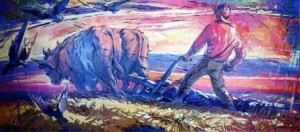 very thick,” he explained, “and he is digging up sections of it with his plow, and stacking the sections. Do you know what he did with the large sections of grass, or sod?” They did not know. “They built houses,” he said joyfully, “sod houses! They stacked it up and made houses from it. Now, why do you think they used sod instead of trees?” The children looked at each other, and looked again at the mural. They did not know the answer. “We have trees in Lincoln now,” he continued, “but many years ago, there were no trees, just prairie grass. No trees! Somebody planted all the trees you see today. There was no wood to build with, so the
very thick,” he explained, “and he is digging up sections of it with his plow, and stacking the sections. Do you know what he did with the large sections of grass, or sod?” They did not know. “They built houses,” he said joyfully, “sod houses! They stacked it up and made houses from it. Now, why do you think they used sod instead of trees?” The children looked at each other, and looked again at the mural. They did not know the answer. “We have trees in Lincoln now,” he continued, “but many years ago, there were no trees, just prairie grass. No trees! Somebody planted all the trees you see today. There was no wood to build with, so the 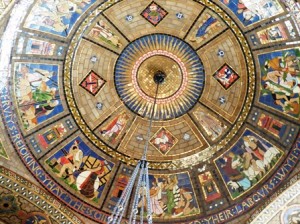 settlers used what they had. And that was sod.” There was a group “ohh” from the children as they thought about that. Jamison continued with the beginnings of Nebraska, pictured right there in the vestibule of the capitol. The capitol’s art is “themed” from beginning to end, reflecting the values of the people of Nebraska. There’s hushed behavior here; the building feels cathedral-like; especially looking up. » read more
settlers used what they had. And that was sod.” There was a group “ohh” from the children as they thought about that. Jamison continued with the beginnings of Nebraska, pictured right there in the vestibule of the capitol. The capitol’s art is “themed” from beginning to end, reflecting the values of the people of Nebraska. There’s hushed behavior here; the building feels cathedral-like; especially looking up. » read more
» posted on Wednesday, June 19th, 2013 by Linda Lou Burton
Life Is Right
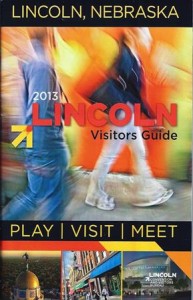 Linda Burton posting from Lincoln, Nebraska – “I’m not stuck-up. I’m just deaf.” Such was the comment made to me by the gentleman to my left, as his wife leaned across to chat. We each were waiting for a table; the restaurant was crowded and a conversation had naturally begun. At least, between the wife and me. Until the husband chimed in, concluding, “That’s why I’m not talking.” He looked directly in my eyes as he spoke, and gave me a quirky smile as though to apologize. His wife smiled too, and gave him a love pat on the shoulder; I smiled back and thanked him for saying that. It was a comfortable moment. And not unusual for Lincoln, I’m finding. Everyone comes across friendly, and open. If people in a community are friendly, and open, then is it logical to conclude that the people in that community are happy? That life is right? The Lincoln Chamber of Commerce believes it; in fact, they have set up a website – www.lifeisright.com – to serve as an outlet for local residents, and visitors, to express why they believe life feels “right” in Lincoln. At “Shout Lincoln” you can record your comments; at “Picture Lincoln” you can add your favorite Lincoln photos. And “Brand Lincoln” is an innovative approach that helps local businesses and organizations customize the Lincoln logo to perfectly fit their
Linda Burton posting from Lincoln, Nebraska – “I’m not stuck-up. I’m just deaf.” Such was the comment made to me by the gentleman to my left, as his wife leaned across to chat. We each were waiting for a table; the restaurant was crowded and a conversation had naturally begun. At least, between the wife and me. Until the husband chimed in, concluding, “That’s why I’m not talking.” He looked directly in my eyes as he spoke, and gave me a quirky smile as though to apologize. His wife smiled too, and gave him a love pat on the shoulder; I smiled back and thanked him for saying that. It was a comfortable moment. And not unusual for Lincoln, I’m finding. Everyone comes across friendly, and open. If people in a community are friendly, and open, then is it logical to conclude that the people in that community are happy? That life is right? The Lincoln Chamber of Commerce believes it; in fact, they have set up a website – www.lifeisright.com – to serve as an outlet for local residents, and visitors, to express why they believe life feels “right” in Lincoln. At “Shout Lincoln” you can record your comments; at “Picture Lincoln” you can add your favorite Lincoln photos. And “Brand Lincoln” is an innovative approach that helps local businesses and organizations customize the Lincoln logo to perfectly fit their 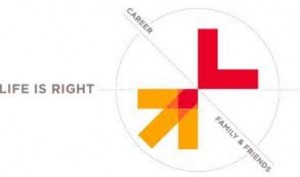 needs. It’s a simple but very eye-catching look: an arrow pointing upward, to symbolize growth and progress, and pointing towards the Lincoln “L.” Rationally, the three segments of the arrow represent the people, places, and events that make up the community; emotionally, they stand for the success, comfort and fun you have when you live in Lincoln. And where the arrow meets the “L” is the sweet spot; that’s what signifies that “life is right” in Lincoln. » read more
needs. It’s a simple but very eye-catching look: an arrow pointing upward, to symbolize growth and progress, and pointing towards the Lincoln “L.” Rationally, the three segments of the arrow represent the people, places, and events that make up the community; emotionally, they stand for the success, comfort and fun you have when you live in Lincoln. And where the arrow meets the “L” is the sweet spot; that’s what signifies that “life is right” in Lincoln. » read more
» posted on Monday, June 17th, 2013 by Linda Lou Burton
Two For One, Special
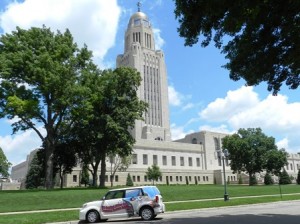 Linda Burton posting from Lincoln, Nebraska – Look carefully at my picture of the Nebraska state capitol. Do you notice anything unusual? I thought it was nice that free parking is available close by, and a sign at the bottom of the steps shows the open hours and the ADA entrance; that’s unusual, but not what I’m referring to. I’m talking about a feature unlike any other capitol in the United States. Thirty-seven capitol buildings have domes and four are skyscraper-highrise in construction. But the Nebraska capitol fits into both categories! A domed highrise, unique
Linda Burton posting from Lincoln, Nebraska – Look carefully at my picture of the Nebraska state capitol. Do you notice anything unusual? I thought it was nice that free parking is available close by, and a sign at the bottom of the steps shows the open hours and the ADA entrance; that’s unusual, but not what I’m referring to. I’m talking about a feature unlike any other capitol in the United States. Thirty-seven capitol buildings have domes and four are skyscraper-highrise in construction. But the Nebraska capitol fits into both categories! A domed highrise, unique 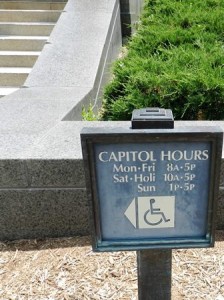 and striking. It’s not the tallest of the three built in the 30’s when economic considerations were primary and Art deco was the design of choice, nor was it the least expensive to build, but it incorporates features that meet the needs of Nebraska citizens with both efficiency and beauty. And behind every element that is functional lies a deeper meaning of what Nebraska is all about. Take that golden dome, for instance. It is symbolic of the sun, so central to the weather of the prairie state; its reflective surface even changes
and striking. It’s not the tallest of the three built in the 30’s when economic considerations were primary and Art deco was the design of choice, nor was it the least expensive to build, but it incorporates features that meet the needs of Nebraska citizens with both efficiency and beauty. And behind every element that is functional lies a deeper meaning of what Nebraska is all about. Take that golden dome, for instance. It is symbolic of the sun, so central to the weather of the prairie state; its reflective surface even changes 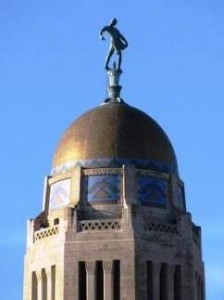 color as the weather changes. Below that, the frieze around the drum depicts thunderbirds, an American Indian symbol of thunder. Atop the dome stands the Sower, arm extended as he spreads the seed in a northwesterly direction, where most of Nebraska’s farmlands lie. These three elements together represent weather and agriculture; symbolically, they are an homage to civilizations of the past – Egyptians, American Indians, and the European settlers. From top to bottom the theme carries through, yet all the spaces are usable, and logically arranged. But it’s not just the building that’s unique, it’s also what happens inside. I’m talking about the legislative system – the only one in the country that is unicameral. » read more
color as the weather changes. Below that, the frieze around the drum depicts thunderbirds, an American Indian symbol of thunder. Atop the dome stands the Sower, arm extended as he spreads the seed in a northwesterly direction, where most of Nebraska’s farmlands lie. These three elements together represent weather and agriculture; symbolically, they are an homage to civilizations of the past – Egyptians, American Indians, and the European settlers. From top to bottom the theme carries through, yet all the spaces are usable, and logically arranged. But it’s not just the building that’s unique, it’s also what happens inside. I’m talking about the legislative system – the only one in the country that is unicameral. » read more
» posted on Saturday, June 15th, 2013 by Linda Lou Burton
In The Neighborhoods
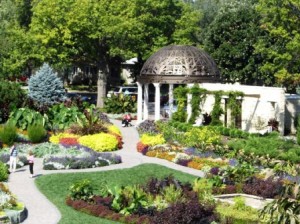 Linda Burton posting from Lincoln, Nebraska – It once was named Lancaster, but its name was changed in a political ploy. It wasn’t built on a large body of water or near any mountains. Without those moderating influences it has a highly variable climate, subject to bitter cold in the winter and heat waves during the summer. Frequent thunderstorms often produce tornadoes and blizzards are possible in the winter. It has little development outside its city limits and no contiguous suburbs. It doesn’t sound like a very appealing place to live, does it? But wait.
Linda Burton posting from Lincoln, Nebraska – It once was named Lancaster, but its name was changed in a political ploy. It wasn’t built on a large body of water or near any mountains. Without those moderating influences it has a highly variable climate, subject to bitter cold in the winter and heat waves during the summer. Frequent thunderstorms often produce tornadoes and blizzards are possible in the winter. It has little development outside its city limits and no contiguous suburbs. It doesn’t sound like a very appealing place to live, does it? But wait. 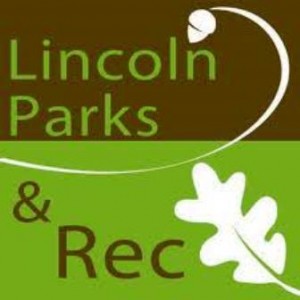 This city, built on gently rolling hills, has over 6,000 acres of parks and natural land, 7 recreation centers, 128 miles of trails, 10 public pools and 5 city golf courses. The goal of the city planners is to have a park area within a half mile walking distance of each residence in the community; in fact, the tagline says “parks and recreation are FUNdamental to the city’s quality of life.” There’s more. A canopy of 125,000 public trees covers the city; 87,000 of them line the 1,217 miles of streets. In fact, the city has been nationally recognized as a Tree City USA by the National Arbor Day
This city, built on gently rolling hills, has over 6,000 acres of parks and natural land, 7 recreation centers, 128 miles of trails, 10 public pools and 5 city golf courses. The goal of the city planners is to have a park area within a half mile walking distance of each residence in the community; in fact, the tagline says “parks and recreation are FUNdamental to the city’s quality of life.” There’s more. A canopy of 125,000 public trees covers the city; 87,000 of them line the 1,217 miles of streets. In fact, the city has been nationally recognized as a Tree City USA by the National Arbor Day 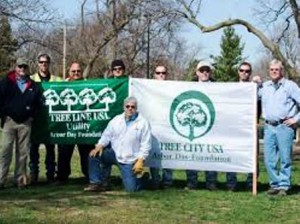 Foundation every year since 1976. And oh yes, the CDC has put it high on the list of “healthiest cities in the USA.” I’m talking about Lincoln, Nebraska, ranked as the 14th most populous capital city with 258,379 (US 2010 Census) residents who are proud to call it home. And it’s been around since 1856, even though it was Lancaster back then. Let me explain what led to the “political ploy” that changed everything. And then I’ll take you around to some of present-day Lincoln’s beautiful neighborhoods. » read more
Foundation every year since 1976. And oh yes, the CDC has put it high on the list of “healthiest cities in the USA.” I’m talking about Lincoln, Nebraska, ranked as the 14th most populous capital city with 258,379 (US 2010 Census) residents who are proud to call it home. And it’s been around since 1856, even though it was Lancaster back then. Let me explain what led to the “political ploy” that changed everything. And then I’ll take you around to some of present-day Lincoln’s beautiful neighborhoods. » read more
» posted on Thursday, June 13th, 2013 by Linda Lou Burton
Itsy Bitsy Spider
 Linda Burton posting from Lincoln, Nebraska – Which frightens you most – spiders or lightning? For me it has always been lightning, like the stuff that welcomed me to Nebraska today in a frenzy of white slashing black over the green prairie to the west. Could I outrun the storm? It was moving west to east; I was traveling south to north; it was a futile contest; I lost. I’ve never seen much lightning before, as I tend to head for cover at the sound of the first thunderclap. Today I had no choice but to look. I had to keep my eyes on the road and sky; there was no place to stop; only open prairie.
Linda Burton posting from Lincoln, Nebraska – Which frightens you most – spiders or lightning? For me it has always been lightning, like the stuff that welcomed me to Nebraska today in a frenzy of white slashing black over the green prairie to the west. Could I outrun the storm? It was moving west to east; I was traveling south to north; it was a futile contest; I lost. I’ve never seen much lightning before, as I tend to head for cover at the sound of the first thunderclap. Today I had no choice but to look. I had to keep my eyes on the road and sky; there was no place to stop; only open prairie. 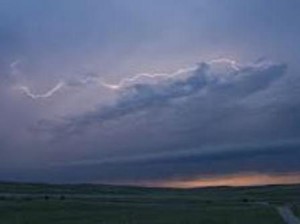 By sheer force nature made me realize just what amazing tricks it can do. Cloud to ground! Cloud to cloud! I counted more than a hundred streaks before the storm engulfed me with rain and then I couldn’t see a thing. Until I reached my hotel and flipped the blinker to signal left. That’s when I saw the spider and forgot the storm. My priorities changed! It was a substantial-looking brown spider, directly above the steering column and crawling down. I grabbed the first thing I could – a piece of paper with today’s driving directions – and smashed it against the spider. I missed. The spider fell to my feet. I’d heard tales
By sheer force nature made me realize just what amazing tricks it can do. Cloud to ground! Cloud to cloud! I counted more than a hundred streaks before the storm engulfed me with rain and then I couldn’t see a thing. Until I reached my hotel and flipped the blinker to signal left. That’s when I saw the spider and forgot the storm. My priorities changed! It was a substantial-looking brown spider, directly above the steering column and crawling down. I grabbed the first thing I could – a piece of paper with today’s driving directions – and smashed it against the spider. I missed. The spider fell to my feet. I’d heard tales 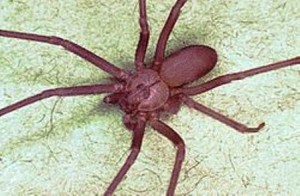 of wrecks caused by insects; although the storm raged around me and traffic whizzed by on either side, my basic instinct was to jump out of the car. But I didn’t. I made it into the hotel parking lot and got the cats and myself inside out of the storm, where I immediately began to read up on spiders. Because after all, that healthy brown arachnid was still in my car. » read more
of wrecks caused by insects; although the storm raged around me and traffic whizzed by on either side, my basic instinct was to jump out of the car. But I didn’t. I made it into the hotel parking lot and got the cats and myself inside out of the storm, where I immediately began to read up on spiders. Because after all, that healthy brown arachnid was still in my car. » read more
» posted on Monday, August 20th, 2012 by Linda Lou Burton
Beyond Numbers
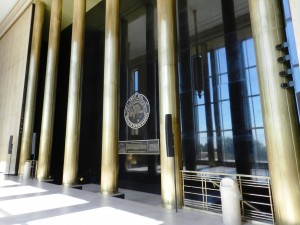 Linda Burton posting from Bismarck, North Dakota – “Over 80 percent of this capitol building is usable space,” the tour guide said. “As compared to Minnesota, say, where they can use only 29 percent. They have that big dome.” The guide has more numbers and comparisons; the North Dakota capitol cost $2 million to build in 1934, the Nebraska capitol, also a highrise, cost $11 million, she says. That’s $.46 per square foot vs $1.10. Frugality was a major consideration when building the North Dakota capitol; this is a state that simply doesn’t spend what it doesn’t have. After the old capitol burned in 1930, they sold 160 acres of land and used insurance money from the burned building to pay for the new capitol. Workers threatened a strike part-way
Linda Burton posting from Bismarck, North Dakota – “Over 80 percent of this capitol building is usable space,” the tour guide said. “As compared to Minnesota, say, where they can use only 29 percent. They have that big dome.” The guide has more numbers and comparisons; the North Dakota capitol cost $2 million to build in 1934, the Nebraska capitol, also a highrise, cost $11 million, she says. That’s $.46 per square foot vs $1.10. Frugality was a major consideration when building the North Dakota capitol; this is a state that simply doesn’t spend what it doesn’t have. After the old capitol burned in 1930, they sold 160 acres of land and used insurance money from the burned building to pay for the new capitol. Workers threatened a strike part-way 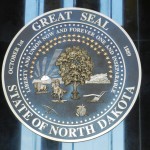 through; laborers asked for a raise from 30 cents an hour to 50. The governor called out the National Guard to protect the partially constructed building; workers were granted a 10 cent raise. Work continued, and the building was first occupied in January 1935. On time, and on budget. One thing I noticed right away; planning may have focused on frugal, and the outside may appear plain, but the building is impressive in its indoor elegance, and its streamlined efficiency. » read more
through; laborers asked for a raise from 30 cents an hour to 50. The governor called out the National Guard to protect the partially constructed building; workers were granted a 10 cent raise. Work continued, and the building was first occupied in January 1935. On time, and on budget. One thing I noticed right away; planning may have focused on frugal, and the outside may appear plain, but the building is impressive in its indoor elegance, and its streamlined efficiency. » read more

